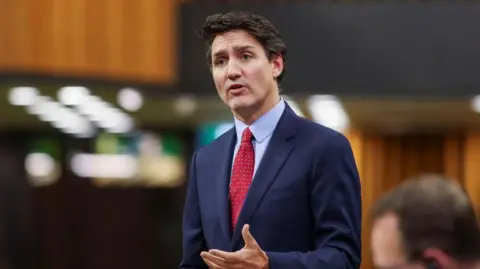Will Trudeau resign? Four ways a Canadian prime minister can take

 Reuters
ReutersThe future of Canadian Prime Minister Justin Trudeau looks uncertain following the sudden resignation of his senior cabinet member, who was close to him.
Chrystia Freeland – former deputy prime minister and finance minister – left her post on Monday with an open letter to Trudeau, in which she outlined her disagreements with him about spending and “the best way forward for Canada”.
The disagreement, he said, has been underscored by the threat of tariffs on Canadian goods from incoming US President Donald Trump – rates that economists say could deal Canada a serious economic blow.
Questions are now being asked on Parliament Hill, including from other members of his Liberal party, about his ability to lead at this critical time.
He is faced with several options on how to move forward.
He listened to calls for him to resign
Trudeau has been the leader of the Liberal Party of Canada since 2013, and the prime minister of Canada for just over nine years, since 2015.
According to the party’s constitution, the leader can hand in his resignation at any time. If it is effective immediately, an interim leader is appointed until the members of the group can meet and vote for a new full-time leader.
Trudeau can also choose to remain in office until a new leader is appointed.
Once a new leader is appointed, Trudeau will have to relinquish his prime ministerial powers and hand them over to his successor.
Wait and weather the storm
Trudeau has given no indication that he will voluntarily resign anytime soon.
In an emergency meeting with his caucus after Freeland’s departure, Trudeau told Liberal members of parliament (MPs) – including those who had asked him to step down – that he would take time to reflect, according to multiple reports.
In a holiday speech to the Liberal Party on Tuesday, he acknowledged that politics has come with “great challenges” but said: “In difficult times, it’s not a time to stand still. It’s a time to be ambitious, courageous.”
Trudeau has been under pressure since the summer, with his approval ratings plummeting and a series of special election losses in once-safe Liberal seats raising serious problems for his party.
In October, he faced a small caucus revolt, with 24 MPs signing a letter asking him to leave.
Polls show that if Canada’s general election were to be held today, the official opposition Conservative Party would be handed a decisive victory.
Trudeau is still holding on despite these problems and has repeatedly vowed to run again as Liberal leader in the next election.
Only 13 of the 153 Liberal MPs have asked to leave – nearly half of them are not seeking re-election, according to CBC News tracking.
However, under the party’s constitution, the position of leader can be legitimately voted on by members following a losing election.
A vote of no confidence launched an election
Top of the popular opinion polls by double digits, the Conservatives have tried for months to start the election by launching a series of no-confidence votes in the House of Commons.
If the government loses a motion of confidence or a vote in the House, it is expected to resign or seek the dissolution of parliament, which will trigger federal elections.
The government needs the support of a majority of 338 members of parliament for a vote of no confidence. The Liberals are 17 seats shy of that.
Conservative efforts failed after the NDP or Bloc Québécois backed the Liberals in order to gain support while advancing their own political priorities.
With parliament adjourning for the holidays on Tuesday, Trudeau won’t face the threat of another confidence motion until at least late January.
On Monday, NDP Leader Jagmeet Singh for the first time called on Trudeau to resign, making the Liberals’ hold on power look shaky.
The leader of the NDP House told broadcaster CBC that its members will vote on a motion of no confidence in him if the prime minister becomes leader in the new year.
Forward the parliament to avoid a vote of no confidence
Another way Trudeau can avoid a vote is to create a parliament – essentially a suspension that will stop all proceedings, including debates and votes, without dissolving parliament.
Although it is a normal part of parliamentary procedure, it is sometimes used by governments to buy time during political crises.
Parliament was recently dissolved by Trudeau in August 2020, when his government faced a scandal over its handling of a contract with a charity.
It was also used to avoid a vote of no confidence in Trudeau’s predecessor, Conservative Prime Minister Stephen Harper, who formed parliament in December 2008 when opposition parties sought to form a coalition government.
Parliament resumed in January 2009. By then the coalition had dissolved, allowing Harper to remain in power.
Whatever Trudeau decides to do, an election in the coming months is inevitable.
Canada must hold its next election in October or sooner, and ultimately, it will be the voters who decide his future.
Source link


